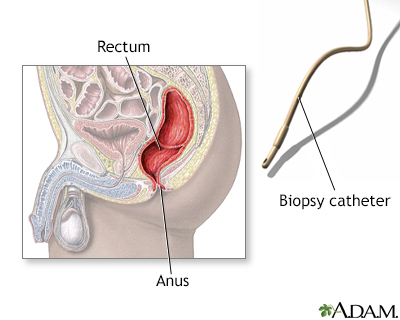The Importance of Colorectal Cancer Screening: How Early Detection Saves Lives
Colorectal cancer ranks as the second leading cause of cancer-related deaths in the United States. Referred to as a “silent killer” due to its lack of…

Update your location to show providers, locations, and services closest to you.
Sigmoidoscopy is a procedure used to see inside the sigmoid colon and rectum. The sigmoid colon is the area of the large intestine nearest to the rectum.
Flexible sigmoidoscopy; Sigmoidoscopy - flexible; Proctoscopy; Proctosigmoidoscopy; Rigid sigmoidoscopy; Colon cancer sigmoidoscopy; Colorectal sigmoidoscopy; Rectal sigmoidoscopy; Gastrointestinal bleeding - sigmoidoscopy; Rectal bleeding - sigmoidoscopy; Melena - sigmoidoscopy; Blood in stool - sigmoidoscopy; Polyps - sigmoidoscopy
During the test:
Sigmoidoscopy using a rigid scope may be done to treat problems of the anus or rectum.
Your health care provider will tell you how to prepare for the exam. You will use an enema to empty your bowels. This is usually done 1 hour before the sigmoidoscopy. Often, a second enema may be recommended or your provider may recommend a liquid laxative the night before.
On the morning of the procedure, you may be asked to fast with the exception of certain medicines. Be sure to discuss this with your provider well in advance. Sometimes, you are asked to follow a clear liquid diet the day before, and sometimes a regular diet is allowed. Again, discuss this with your provider well in advance of your test date.
During the exam you may feel:
After the test, your body will pass the air that was put into your colon.
Children may be given medicine to make them sleep lightly (sedated) for this procedure.
Your provider may recommend this test to look for the cause of:
This test can also be used to:
All adults should have a colon cancer screening test starting at age 45. For people with an average risk for colon cancer, flexible sigmoidoscopy every 5 years or every 10 years plus stool testing with FIT done every year is one screening option.
A normal test result will show no problems with the color, texture, and size of the lining of the sigmoid colon, rectal mucosa, rectum, and anus.
Abnormal results can indicate:
There is a slight risk of bowel perforation (tearing a hole) and bleeding at the biopsy sites. The overall risk is very small.



Pasricha PJ. Gastrointestinal endoscopy. In: Goldman L, Schafer AI, eds. Goldman-Cecil Medicine. 26th ed. Philadelphia, PA: Elsevier; 2020:chap 125.
Rex DK, Boland CR, Dominitz JA, et al. Colorectal cancer screening: recommendations for physicians and patients from the U.S. Multi-Society Task Force on Colorectal Cancer. Am J Gastroenterol. 2017;112(7):1016-1030. PMID: 28555630 www.pubmed.ncbi.nlm.nih.gov/28555630/.
Sugumar A, Vargo JJ. Preparation for and complications of gastrointestinal endoscopy. In: Feldman M, Friedman LS, Brandt LJ, eds. Sleisenger and Fordtran's Gastrointestinal and Liver Disease. 11th ed. Philadelphia, PA: Elsevier; 2021:chap 42.
US Preventive Services Task Force website. Final recommendation statement. Colorectal cancer screening. www.uspreventiveservicestaskforce.org/uspstf/recommendation/colorectal-cancer-screening. Published May 18, 2021. Accessed November 25, 2022.
Colorectal cancer ranks as the second leading cause of cancer-related deaths in the United States. Referred to as a “silent killer” due to its lack of…
